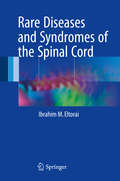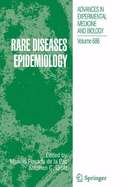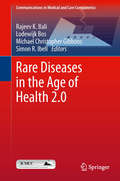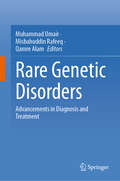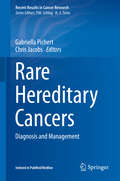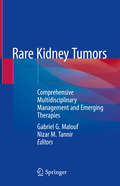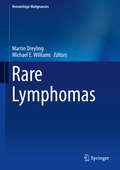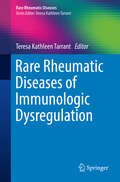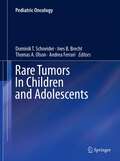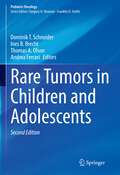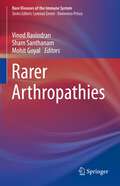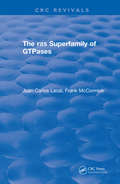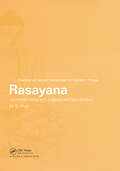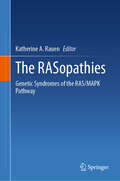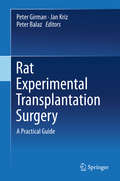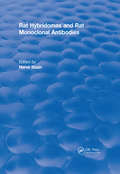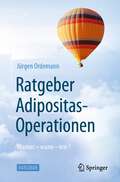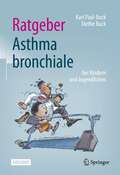- Table View
- List View
Rare Diseases and Syndromes of the Spinal Cord
by Ibrahim M. EltoraiThis book provides a comprehensive and up-to-date review of rare diseases and syndromes of the spinal cord, collected over the past forty years from all the world's literature. Each chapter in this volume is organized in the same easy-to-follow format, comprising definitions, incidence, etiology, clinical presentation, diagnosis, management, prognosis, and references. This book is aimed at medical students, residents, fellows, and junior attendings in spinal cord medicine, physical medicine, neurosurgery, orthopedics, oncology, emergency medicine, infectious disease, neurology, genetics, vascular surgery, and endocrinology, along with the numerous allied fields of physical therapy, nursing, occupational therapy, and biomedical researchers.
Rare Diseases Epidemiology
by Manuel Posada de la Paz Stephen C. GroftThe Rare Diseases Epidemiology book is a comprehensive text focused on the rare disease field where both general epidemiological methods and specific methods for low prevalence diseases are discussed. This is the first book to address rare diseases as a public health problem where the epidemiological research constrains are analyzed and at the same time, solutions and also data by rare diseases groups are provided. This book is probably a starting point for developing better future epidemiological research programs on rare diseases, and also research strategies in fields such as health planning and decision making, which will be able to promote not only new knowledge but also capacity building for policy makers. Epidemiology is always mentioned in all rare diseases policy documents as an important topic but a comprehensive book on this discipline applied to rare diseases, had never been written before.
Rare Diseases in the Age of Health 2.0
by Rajeev K. Bali Lodewijk Bos Michael Christopher Gibbons Simon IbellThis text focuses on various factors associated with orphan diseases and the influence and role of health information technologies. Orphan diseases have not been adopted by the pharmaceutical industry because they provide little financial incentive to treat or prevent it. It is estimated that 6,000-7,000 orphan diseases exist today; as medical knowledge continues to expand, this number is likely to become much greater. The book highlights the opportunities and challenges in this increasingly important area. The book explores new avenues which are opened by information technologies and Health 2. 0, and highlights also economic opportunities of orphan disease medicine. The editors of this new book have international experience and competencies in the key areas of patient empowerment, healthcare and clinical knowledge management, healthcare inequalities and disparities, rare diseases and patient advocacy.
Rare Genetic Disorders: Advancements in Diagnosis and Treatment
by Muhammad Umair Misbahuddin Rafeeq Qamre AlamThis book introduces different Rare Genetic Disorders (RGDs), and challenges in their diagnosis. The chapters of the book discuss the emerging research and clinical approaches for the diagnosis of rare genetic disorders. It further reviews the future of genetic therapies for the treatment of rare genetic diseases and examine the recent advancements in the field of genetic testing for the diagnosis of these diseases. The book also covers the role of variants in the genome (genetic modifiers) that alleviate (suppress) or exacerbate (enhance) the severity of the disease, resulting in the variability of phenotypic outcomes. Further, the book examines different animal models for critical understanding of disease mechanisms, and the opportunity to evaluate the effect of therapeutic compounds in pre-clinical studies. The subsequent chapters present the state-of-the-art drug discovery strategies and biological approaches for the treatment of rare genetic disorders. Towards the end, the book reviews the current challenges in the diagnosis and treatment of the patients of rare genetic disorders and future opportunities. This book is useful for clinical geneticists, molecular and biochemical geneticists, researchers working in gene therapy and genome editing.
Rare Genitourinary Tumors
by Lance PagliaroRare Genitourinary Tumors offers the reader an up-to-date discussion of the less common neoplasms affecting the urinary tract and reproductive organs. Each authoritative chapter provides and in-depth discussion that is frequently not found in other urologic oncology textbooks. A valuable reference for urologists, oncologists, and those in specialty training, this volume provides ready access to information on etiology, incidence, risk factors, diagnosis, prognosis, insights from molecular pathology and, where applicable, data from clinical trials. The practical treatment guidelines included for each tumor type are written by experts and fully referenced.
Rare Hereditary Cancers
by Gabriella Pichert Chris JacobsThis book approaches the differential diagnosis and management of rare, hereditary cancer syndromes from a practical angle, addressing the issues pertinent to each tumour type as encountered by health professionals in their day-to-day practice. This book enables readers to correctly identify patients with rare cancer syndromes who would benefit from genetic counselling and testing, and provides the necessary knowledge for appropriate patient management and advising at-risk family members. It begins by describing recent advances in genetic testing for cancer-predisposing genes. Leading experts from Europe and Australia then offer detailed, up-to-date guidance on the diagnosis and management of a wide range of hereditary cancers. The concluding chapter examines the wider issues that are raised by genetic testing for rare cancer syndromes for patients, families and health professionals. This book is an invaluable source of information for all specialists involved in the care of such patients and their families.
Rare Kidney Tumors: Comprehensive Multidisciplinary Management and Emerging Therapies
by Gabriel G. Malouf Nizar M. TannirThis book provides clinicians with clear guidance on treatment decision-making in patients with rare kidney cancers. After a brief review on epidemiology, pathology, and biology, each chapter focuses on the multidisciplinary management of a particular tumor subtype using the full range of available cancer therapy modalities, including surgery, radiotherapy, chemotherapy, targeted therapies, and immunotherapy. Emerging therapies and future directions in the management of each cancer subtype are also discussed. The chapters are all written by multidisciplinary teams of international experts comprising at least a urologist, a medical oncologist, and a pathologist. Rare kidney cancers represent 15% of renal cell carcinomas. In comparison with clear cell renal cell carcinomas, little is known about the biology of such cancers, and few trials have reported on the efficacy of targeted therapies in the metastatic setting. Optimal management thus poses significant challenges and often requires a multidisciplinary team. This book will be an ideal reference guide for all clinicians involved in the care of patients with these orphan tumors.
Rare Lung Diseases: A Comprehensive Clinical Guide to Diagnosis and Management
by Sujith V. Cherian Anupam KumarThis book aims to be a complete guide to diagnose, manage, and treat rare lung diseases encountered by practicing pulmonologists and trainees. It extensively covers the "more common" of the rare lung diseases, categorizing them based on developmental lung anomalies in adults, airway disorders, diffuse parenchymal lung diseases, neoplasms, rare vascular disorders, and other miscellaneous conditions. This comprehensive review facilitates the study and understanding of this complex and diverse set of disorders, focusing on differential diagnosis, evidence-based discussions of management algorithms, and thoughtful analysis of treatment options. Key Features * Reviews multiple rare lung diseases, including ones acquired congenitally to be expressed in old age * Enriched with case studies and illustrations to guide respiratory physicians and trainees to devise an effective treatment plan *Focuses on concerned investigations, with a section on the role of new procedures in management
Rare Lymphomas
by Martin Dreyling Michael E. WilliamsAfter a decade of tremendous progress in the diagnostic and therapeutic approaches to malignant lymphoma, optimal treatment strategies are now based not only on accurate diagnosis but also on thorough evaluation of clinical and molecular risk factors. Even more importantly, molecular targeted approaches have been shown to be effective in the treatment of distinct lymphoma subtypes. Against this background, clinical management of especially the rare lymphomas remains a challenge for the general oncologist. This book provides a comprehensive overview of current treatment strategies in these rare lymphoma subtypes. Experts in the field from around the world describe histomorphology in a clinically relevant manner, consider the role of risk factors in detail, and discuss the spectrum of therapeutic approaches. Special emphasis is placed on the translation of molecular science into clinical care, and a disease-specific algorithm is proposed for each entity.
Rare Malignant Skin Tumors
by Franco Rongioletti Irina Margaritescu Bruce R SmollerThis book provides practitioners with a single volume that reviews the clinical and pathologic features of rarely encountered cutaneous neoplasms. The text includes an in-depth discussion of the clinical findings, as well as the histologic and immunologic features of these diseases that are rarely encountered, reported, or recognized. Additional laboratory data used to make and support the diagnoses with some therapeutic and prognostic hints are discussed for each entity. The volume is organized into general categories correlating with the cell(s) of origin. An atlas of clinical manifestations is presented for each entity that will serve as a bedside clinical reference, followed by a series of photomicrographs depicting the histologic changes. In all cases, recent updates on molecular tools helpful in attaining the diagnosis are added to the sections on histology and immunohistochemistry. Rare Malignant Skin Tumors is a valuable bedside reference for the practicing dermatopathologist, general pathologist reviewing skin biopsies, general dermatologists, cutaneous oncologists and Mohs' surgeons.
Rare Rheumatic Diseases of Immunologic Dysregulation (Rare Rheumatic Diseases)
by Teresa Kathleen TarrantThis book is a practical, user-friendly guide for diagnosing and treating patients with rare rheumatic diseases of immunologic dysregulation. Covering uncommon diseases such as IgG4-Related Disease, Castleman’s Disease, and Felty Syndrome, chapters aggregate information from case reports and anecdotal literature to create a single, comprehensive handbook for treating patients. Each chapter provides historical perspective and epidemiology; a literature review (including research trials, translational research, historical and current case reports, and case series); pathogenesis; clinical presentation; laboratory evaluation; imaging; histopathology; treatment; and outcomes. Rare Rheumatic Diseases of Immunologic Dysregulation is an invaluable resource for rheumatologists, rheumatology fellows, and clinical immunologists to better diagnose and treat patients with rare rheumatic diseases.
Rare Sarcomas
by Christine Chevreau Antoine ItalianoThis is a unique book focusing on the management of rare sarcomas, which pose an important challenge in Europe and in the US, as they represent nearly one quarter of all new diagnoses of cancer and have lower survival rates than common cancer. Discussing a range of tumors from clear cell and epithelioid sarcoma to solitary fibrous tumor and myxoid fibrosarcoma, this book provides invaluable expertise according to evidence-based guidelines and uses a patient-centered multi-disciplinary approach.Each of the chapters discusses the forms of rare sarcomas both from an oncological and a pathological perspective. This book aims to help the sarcoma expert in improving the management, quality of care and outcome for patients with rare tumors, which have now been recognised as a public health priority.The authors are experts from specialist sarcoma centers focusing on the capacity to develop clinical guidelines, and to foster clinical, translational and epidemiological research for rare cancers.
Rare Tumors and Tumor-like Conditions in Urological Pathology
by Antonio Lopez-Beltran Carmen L. Menendez Rodolfo Montironi Liang ChengThis book is a comprehensive guide to rare tumors and tumor-like conditions of the urinary system and male genital organs. It comprises five chapters, devoted to the kidney, bladder, prostate, testes, and penis. Each chapter begins with a brief overview of "common" tumors and tumor-like conditions and with a section on the classification of both common and rare entities. The main clinical, pathological, immunohistochemical, and molecular findings for each rare tumor or tumor-like condition are then described and discussed. Significant characteristics are also documented by representative high-quality illustrations, with emphasis on those aspects of most relevance to differential diagnosis. In addition, prognostic features are fully covered. Urological Pathology: Rare Tumors and Tumor-Like Conditions will be ideal source of core information and practical guidance for residents, fellows, pathologists, urologists, and oncologists.
Rare Tumors In Children and Adolescents
by Ines B. Brecht Dominik Schneider Thomas A. Olson Andrea FerrariThis is the first book to be devoted exclusively to rare tumors in children and adolescents, and its aim is to provide up-to-date information on their diagnosis and clinical management. The opening section addresses general issues including epidemiology, risk factors/etiology, biology and genetics, early detection, and screening. It also discusses solutions to assist in the management of rare tumors, such as international networking and internet platforms. In the second section, specific malignancies are described, with practical guidance on diagnostic workup, multimodal therapy, follow-up, and adverse effects. Discussion of differential diagnosis encompasses both frequent and rare tumor types, which should enable the clinician to take rare entities into account during the diagnostic assessment. Each chapter goes on to provide detailed therapeutic guidelines for specific rare tumors. The authors are a multidisciplinary group of specialists who have dedicated themselves to this group of tumors.
Rare Tumors in Children and Adolescents (Pediatric Oncology)
by Dominik T. Schneider Ines B. Brecht Thomas A. Olson Andrea FerrariThis is the first book to be devoted exclusively to rare tumors in children and adolescents. The completely revised and updated second edition reflects the significant progress that has been accomplished as a result of intensified international networking, deeper implementation of novel diagnostic tools, and the advent of molecular targeted therapies. Readers will find practical guidance on all aspects of clinical management, including diagnostic workup, multimodal therapy, follow-up, and management of adverse effects. The discussion of differential diagnosis encompasses both frequent and rare tumor types, enabling clinicians to take rare entities into account during diagnostic assessment of childhood tumors. Detailed therapeutic recommendations, developed in an international consensus process, are provided for specific rare tumors. In addition, general issues such as epidemiology, etiology, risk factors, biology and genetics, early detection, and screening are fully covered. The book is written by an international and multidisciplinary group of specialists and will be an important compendium for all pediatric oncologists who care for patients with rare tumors.
Rarer Arthropathies (Rare Diseases of the Immune System)
by Vinod Ravindran Sham Santhanam Mohit GoyalThis volume on Rarer Arthropathies, part of the series "Rare Diseases of the Immune System" aims to fill a gap in the literature by informing and updating clinicians on the unusual and uncommon forms of arthritis and related musculoskeletal conditions. It will be a valuable go-to resource for clinicians to support them in differential diagnosis, in particular when facing unusual presentations. Nineteen chapters written by experts have covered a wide range of these conditions, providing first rate information on topics yet lacking adequate coverage; from Palindromic Rheumatism to SAPHO Syndrome and other chronic immune-mediated conditions, while also including arthritis in leprosy, tuberculosis and chikungunya.Smaller, crisp paragraphs and apt subheadings will help the readers in easily understanding the up to date information provided in the chapters. Line diagrams, original full-color clinical photographs and informative tables also support easy assimilation of information, turning this book in a useful ready reckoner on the desks and smartphones. All specialists, including rheumatologists, orthopedic surgeons, pediatricians, physicians practicing internal medicine and rehabilitation medicine will find this volume invaluable in their daily clinical work.
The ras Superfamily of GTPases (CRC Press Revivals)
by Juan Carlos Lacal Frank Patrick McCormickThe ras Superfamily of GTPases presents the most comprehensive compilation of information available regarding aspects of the putative function of small ras-related GTPases. The book's chapters were written by the world's most prominent scientists in this field and cover such topics as the structure and properties of ras proteins, ras function, the ras superfamily in general, and the functional regulation of ras and ras-related GTPases. The book will benefit cell biologists, oncologists, neurobiologists, molecular biologists, and others interested in the topic.
Rasa Shastra: The Hidden Art of Medical Alchemy
by Vaidya Atreya Smith Andrew MasonThe first comprehensive analysis of Asian Medical Alchemy, this book describes the use of herbo-mineral-metal based medicines as used in some of the world's oldest healing traditions. It offers a detailed exploration of Âyurvedic medicinal purification practices that seek to enhance the therapeutic potential of materials, metals and gemstones, as well as offering a concise overview of traditional and modern equipment and methods used in the manufacture of these medicines. The author's unique and fascinating account of the hidden alchemical arts also explains some of the historical background behind the on-going quest amongst Asian alchemists for immortality.
Rasayana: Ayurvedic Herbs for Longevity and Rejuvenation (Traditional Herbal Medicines for Modern Times)
by H.S. PuriUntil relatively recently, much of the information on India's research into their medicinal plants has remained within India, mainly published within Indian journals. However, today the field of Ayurveda is expanding, with the integration of herbs and minerals discovered in other countries and the strengthening of academic knowledge networks worldw
The RASopathies: Genetic Syndromes of the RAS/MAPK Pathway
by Katherine A. RauenThis book presents comprehensive coverage of the RASopathies, one of the largest known recognizable patterns of malformation syndromes, affecting approximately 1 in 1,000 people. These syndromes include neurofibromatosis type 1, Noonan syndrome, Noonan syndrome with multiple lentigines, Costello syndrome, cardio-facio-cutaneous syndrome, Legius syndrome, capillary malformation-arteriovenous malformation syndrome, SYNGAP1 syndrome and central conducting lymphatic anomalies. Noted physician and authority Katherine Rauen and an assembly of the top international experts present detailed discussions of both the science and clinical implications of these fascinating disorders. The major topics covered in this book include the syndromes and genes, the RAS pathway, phenotypic features, animal modeling and treatments. The book will appeal to a wide audience, including clinicians and basic scientists alike such as medical geneticists, genetics counsellors, oncologists, neurologists, cardiologists, dermatologists, behavioralists, orthopedists, ophthalmologists, neuroscientists, RAS biologists, and signal transductionists. This book is also intended for advocate leaders, trainees, and families with RASopathies.
Rat Experimental Transplantation Surgery
by Peter Girman Jan Kriz Peter BalazThe aim of the book is to describe tested microsurgical procedures of kidney, pancreas, islets, heat, liver and small bowel transplantation. All procedures written in the book are used in our experimental research laboratory and their description will be provided by an experienced researcher. The book is organized into 'General' and 'Specific' sections. The 'General' section will include principles, doses and available drugs for rat anaesthesia, the surgical anatomy of the rat, a brief review of immunosuppressant's used in rat models, a description of basic surgical techniques and blood sampling. The 'Specific' section will include a description of the rat model with the appropriate organ failure relevant to the organ transplantation, which will be followed by a detailed description of the surgical procedure with high quality pictures of key steps. Each chapter will describe 'tips and tricks' including practical advice and recommendations.
Rat Genomics
by Ignacio AnegonGrown exponentially by the genomic revolution, the use of the rat as a model of choice for physiological studies continues in popularity and at a much greater depth of understanding. In Rat Genomics: Methods and Protocols, world-wide experts provide both practical information for researchers involved in genomic research in the rat along with a more contextual discussion about the usefulness of the rat in physiological or translational research in different organs and systems. The volume extensively covers topics including genome sequencing, quantitative trait loci mapping, and the identification of single nucleotide polymorphisms as well as the development of transgenic technologies such as nuclear cloning, lentiviral-mediated transgenesis, gene knock-down using RNA interference, gene knock-out by mutagenesis, and zinc finger nucleases plus exciting advances in the obtention of rat embryonic cell lines. As a volume in the highly successful Methods in Molecular BiologyTM series, this work provides the kind of detailed description and implementation advice that is crucial for getting optimal results. Comprehensive and up-to-date, Rat Genomics: Methods and Protocols thoroughly covers the current techniques used in labs around the world and overviews the applications of the data obtained, making it certain to be useful to the scientific community as a key source of references and methods.
Rat Hybridomas and Rat Monoclonal Antibodies (CRC Press Revivals)
by Herve BazinThe purpose of this book is to provide information which supports the fact that rat hybridomas are no more difficult to develop than mouse hybridomas. This is the first book devoted to the development of rat hybridomas. It includes theories, step-by-step techniques, ingredients and apparatus. The focus of this work is on the antibody repertoire, the unique biological properties of rat immunoglobulins, the one-step purification procedure by immunoaffinity chromatography, the absence of C-type particles, and the easy production of large amounts of ascitic fluid containing rat MAb. This rare publication is an absolute must for all scientists using MAbs and those interested in the fields of immunology, biotechnology, and biochemistry.
Ratgeber Adipositas-Operationen: Warum - wann - wie?
by Jürgen OrdemannSoll ich mich wegen meines Übergewichts operieren lassen?Die Fragen, die sich dazu stellen, werden in dem Ratgeber von einem erfahrenen Chirurgen umfassend beantwortet: - was ist Übergewicht und was ist Adipositas?- warum ist eine konservative Therapie so schwierig?- welche Operationsverfahren gibt es, und wie wirken sie?- wann ist eine adipositaschirurgische Operation überhaupt sinnvoll?- wie verläuft der Krankenhausaufenthalt?- wie verläuft der Kostaufbau?- was muss ich nach der Operation beachten?- wenn das Gewicht wieder ansteigt, was dann?Ein adipositaschirurgischer Eingriff kann Gesundheit und Lebensqualität nachhaltig verbessern; neben der Gewichtsreduktion kann die bariatrische Operation zahlreiche Begleiterkrankungen beeinflussen oder sogar ganz zum Verschwinden bringen, darunter Diabetes mellitus Typ II, Bluthochdruck und Fettleber.Es lohnt sich, sich zu informieren!
Ratgeber Asthma bronchiale bei Kindern und Jugendlichen
by Karl Paul-Buck Dietke BuckIn diesem Buch können Eltern zusammen mit ihren erkrankten Kindern allgemeinverständliche, aber umfassende Informationen über Asthma bronchiale nachlesen und erhalten wertvolle Tipps für den Umgang mit der Erkrankung. Gespickt mit vielen Illustrationen für Kinder, erklärt das Buch alles, was sie und ihre Eltern über Asthma wissen müssen.Die Autoren klären viele alltagsrelevante Fragen und helfen damit den Erziehungsberechtigten, über die Therapie mit zu bestimmen und so zu vermeiden, dass die Lebensqualität der betroffenen Kinder vermindert ist. Dieser Asthmaratgeber berücksichtigt die neuesten Therapiekonzepte und enthält ein Asthmalexikon mit Erklärungen medizinischer Fachbegriffe sowie nützliche Adressen und Links.
